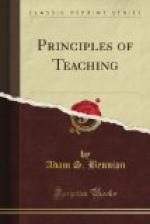3. The Special Topic Method. Much can be said both for and against the topic method. At least three objections to its use can be raised:
A. It makes for piece-meal preparation. The lesson is partitioned off into segments, one of which may be prepared by a particular pupil who does not concern himself at all with the rest of the lesson. This method, therefore, encourages fragmentary and incomplete preparation.
B. It makes for a disconnected presentation which makes it quite impossible for pupils to get a unified conception of the whole lesson. This is doubly bad, because of the fact that frequently those who are assigned parts absent themselves from class.
C. It often results in dull, commonplace recitations. All too frequently, especially if topic assignments are the usual method of procedure, those pupils given the various topics to work up content themselves with very meagre preparation. They come to class, therefore, and merely run over so many facts wholly without inspiration and often by constant reference to notes or the text.
Of course, these difficulties can be overcome largely by the judicious use of the topic method. It ought not generally to be followed as the regular order of business, but rather as a supplementary means of enriching the lesson. It ought not to be used so as to excuse all class members from regular preparation of the lesson as a whole. If the teacher will assign the lesson proper to all of the class and then select certain aspects—certain suggested problems—for more intensive research, the reports on special topics can be made to contribute wonderfully to the richness of the class hour. The topic method, then, is primarily a supplemental method, and if wisely used has these advantages:
A. It makes for an enriched lesson. It makes possible expert opinion, and the results of special, careful investigation which the class as a whole would be unable to make.
B. It lends variety to class procedure and guarantees that the teacher will not do all the talking.
C. It fosters individual expression. It trains pupils to formulate an attack, to organize findings, and to stand and deliver a connected and well thought out message.
D. It promotes a habit of investigation—it leads pupils to work out for themselves the problems of the Gospel which they encounter.
4. The Lecture Method. The comment of a student of the Brigham Young University on the lecture method was unique: “The lecture method wouldn’t be so bad if a teacher really lectured—he usually just talks. And talking a lot when you haven’t much to say is pretty discouraging to a class.”




